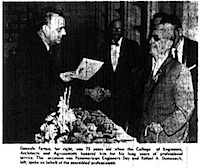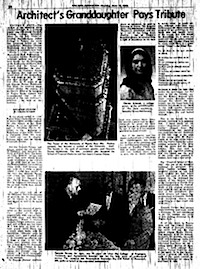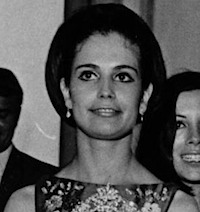"Architect's Granddaughter Pays Tribute" San Juan Star, June 16, 1968
Editor's Note: The author of the following piece, Clarisa Echandi, 20, is a college junior who will attend Cardinal Cushing College, Brookline, Mass. in the fall. While attending Chamberlain Junior College in Boston, she wrote the following article on her grandfather, Gonzalo Fernós Maldonado. As a Father's Day tribute it is reprinted here from "Folio", the college's Manuscript Club Publication.
Gonzalo Fernos Maldonado, architect, painter and poet, is best known for the designing of the University of Puerto Rico Tower and the School of Tropical Medicine. He also designed the Customs House, La Marina, San Juan and the grand door of the sanitarium. He was born on Jan. 10, 1887 and died on Sept. 22, 1966. For close to 17 years of his life Gonzalo Fernos Maldonado was blind. He received many honors during the course of his life. Dr. Oller of the Institute of Puerto Rican Culture has recommended that an exposition of the late architect's paintings be held at the Institute.
"Gonzalo Fernos"
by Clarisa Echandi
As the plane curled in over Puerto Rico, I looked down upon El Morro Castle, antique against the blue waters of San Juan Harbor. It is as nostalgic a sight to returning to Puerto Riqueños as the Escorial to Madrileños or the Eiffel Tower to Parisians. Only this time I could not see it clearly. Between there was the image of Gonzalo Fernos.
For me, Gonzalo Fernos had always meant the old district of Santurce, and Santurce the heart of Puerto Rico. The home on Calle Belaval, behind iron gates that were closed every night according to the custom of the older part of San Juan, half hidden behind the countless palm trees, had become for me, even as a child, a place where i could lose myself in the auroa that Gonzalo Fernos cast about the rooms. Long after I had left Santurce for the United States, that room that he inhabited remained for me all that Puerto Rico should be--ah, yes, if--.
No one ever told me of his childhood. But in the process of growing up, he must have set his talents to all the arts that bloom so well in the Latin soul.
There were sheaves of poetry lying on the ancient desk in the corner of his room, manuscripts with uneven lines but with clear and beautiful thoughts. When I visited Gonzalo Fernos some five years ago, and walked into his room as I had done so often as a very young child, there was a single poem there, with the inscription, "Ofrenda--para mi esposa Luz", and I cried over it. So beautiful an offering was it form a man to his wife. Even now, planning over the city, I hear again his rhapsodic, "A La Vieja Ciudad de San Juan--Dormida sobre las aguas--El Yunque vela su sueño"--in that strangely lyrical voice that remains clear to my memory.
In Gonzalo Fernos' eighteen years of blindness, he took to listening to music. His favorite piece was Beethoven's Moonlight Sonata. I remember one day as I sat in the living room playing one of the Chopin's beautiful pieces, he netered with a light of happiness on his face that was always there when he heard a piece that he liked. Although he never did take guitar lessons, he played guitar by ear. It was as if his musical soul had no need of eyes.
But if his poetry and his music suffered only a little from his sightlessness, this could not be true of his paintings and his architectural drawings. The beach at Yardley Place saw him n more except when he and Luz walked there arm in arm, she no doubt coloring in words what he could not see, although even that was unnecessary for there were still several of his paintings in that house that had caught some of the scenes that Luz would be describing. In a sense he could still see the colors around Santurce and Yardley Place for he wrote about the in a poem called "Ciego"--the Blind One.
Ya no luce la luz que alegra el Alma/ Ni brillan las estrellas en el Cielo,/ Ni las campas se visten con Sus galas,/ Cuando por el oriente rompe El alba,
Ni la luna se asoma entre las Nubes/ Para mirarse en las tranquilas Aguas,/Porque ya se cerraron las/ Ventanas por donde antes, se /Asomaba el alma.
No more is there the light that makes the soul happy, nor the stars in the sky that twinkle, nor are the flowers dressed with their court dresses when through the orient the day breaks, nor the moon look out between the clouds to see itself in the still waters, because already the windows are closed where before, the soul looked through.
This is the beauty he had already captured in a painting that I loved above all the rest--"Atardecer sobre el Caribe" (Sunset over the Caribbean)--In this painting you could see the old buildings of Old San Juan at the edge of the ocean with El Morro Castle at the edge of the island with big waves from the ocean coming towards it. The deep blue sky above put the final touches. This was such a realistic and beautiful painting that you could see the soul of the artist who painted it. Indeed, here was a true artist.
The "tropical School of Medicine" was one of the beautiful buildings he designed. This white marble building had beautiful statues on top, and such original art that would catch the eyes of those who passed by. He designed the outside of the famous tower of the University of Puerto Rico and helped design the Capitol. Much of his original architecture could be seen on the grand door of the sanitarium. One could always tell where the architecture of Gonzalo Fernos was because there was something in it that would stay with you.
Gonzalo Fernos was always experimenting and once made a telescope. He was considered to be the number one artist of pen etching drawings in all Puerto Rico.
In all my years in Puerto Rico and the United States, the image of Gonzalo Fernos has never left me. He was unique among Puerto Ricans. The memory of all his culture, his spirit, his gentility, his room filled with paintings, radio and record player--but no television--has been for me a calling home. During all these years, I have prayed that Gonzalo Fernos would be able to see again. So he did, finally, not as I prayed, but with the sight of the spirit (which he so much believed in) when he died Sept. 12, 1966.
>>insets<<
1) The Tower of the University of Puerto Rico (Rio Piedras campus), has become a symbol of the University itself. The facade is the work of architect, painter, poet Gonzalo Fernos Maldonado. The late architect also designed the School of Tropical Medicine and San Juan's Custom House.
2) Gonzalo Fernos, far right, was 75 years old when the College of Engineers, Architects, and Agronomists honored him for his long years of professional service. The occasion was Pan-American Engineer's Day and Rafael A. Domenech, left, spoke on behalf of the assembled professionals.



